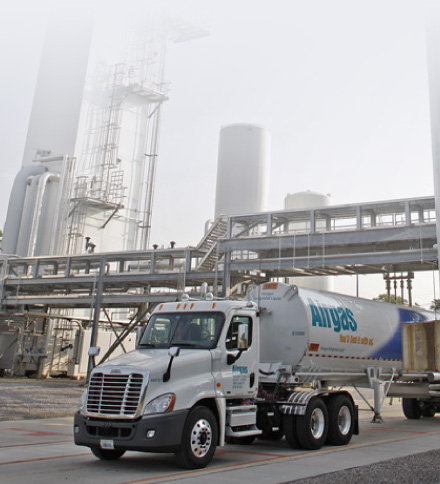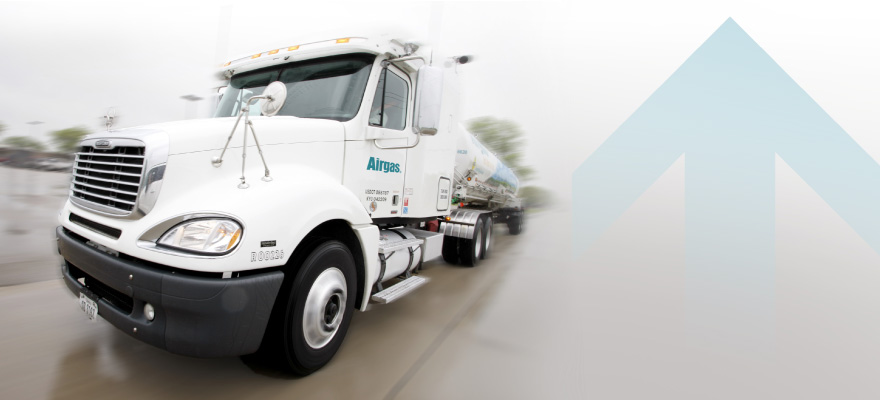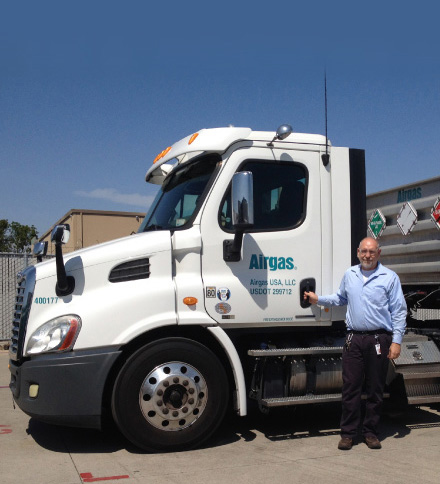
Responsibility:
Energy Efficiency
As part of our commitment to environmental stewardship, we recognize stakeholders' concerns regarding the impact of greenhouse gas emissions—generated by energy and fuel consumption—on the global climate. We are working to become a more energy-efficient company and our focus is on the two largest sources of energy consumption: our 16 air separation units and our more than 5,200 trucks that deliver our products to customers.
Electric Power Usage at Our Air Separation Units
Airgas has a growing number of air separation units (ASUs) where we separate atmospheric air into its primary elements—nitrogen, oxygen and argon—for transport and sale to customers in liquid form and to our fill plants for repackaging. It's an energy-intensive process; electricity accounts for nearly 65 percent of total production costs at the ASUs and represents a significant portion of Airgas' total electricity consumption.
For these reasons, ASUs are a natural focus of our sustainability efforts. During the last several years, we decommissioned our two most inefficient plants, and as we build new ASUs—three are currently under construction—we design in high-efficiency motors and advanced control systems to reduce energy consumption. The high-efficiency motors provide the same amount of horsepower but consume less electricity. The computer control systems allow us to optimize efficiency by maximizing product recovery and minimizing energy consumption. This equipment is also part of all upgrades to our legacy plants.
Average Annual Electric Power Consumption at Air Separation Units
(kilowatt hours per hundred standard cubic feet (cscf))
2013 2.01
2014 2.00
Columbia, SC: Using Less Energy at a Legacy ASU
While Airgas ASUs are designed to operate at peak efficiency during high demand periods, also called "high load levels," we want to be as energy efficient as possible no matter how hard the plants are working. By introducing higher-efficiency motors and advanced control systems, we are now consuming less energy at all load levels, even at our older air separation units.
A good example is our ASU in Columbia, SC, a plant that has been a part of our ASU network since 1996. Energy use was steadily increasing as aging equipment became less efficient. In 2014, we began installation of Advanced Process Control, which manages energy consumption, optimizes the process and maximizes product recovery. As a result, average energy use decreased from 2013 to 2014: a 13 percent reduction at high load levels, 8 percent reduction at medium load levels and 16 percent reduction at low load levels. The decrease is equivalent to eliminating the average annual energy use of 800 typical U.S. homes.
Airgas air separation units (ASUs) are designed to be as energy efficient as possible.

Diesel Fuel Usage in Our Truck Fleets
Airgas operates one of the largest private truck fleets in the U.S., so it makes sense for both our business and our sustainability efforts to increase the fuel economy of our distribution vehicles. In 2014, our fleet of more than 5,200 vehicles covered more than 130 million miles, from rural roads to crowded city streets.
To date, most of our fuel efficiency efforts have focused on our bulk fleet because that is where we can see the most impactful and immediate improvements. All bulk trucks are now equipped with three-minute idle-time shut down devices, plus lightweight aluminum components and wide-based tires that enable better fuel mileage.
In early 2015, we installed electronic on-board computers in 31 percent of our bulk fleet. They connect into the engine computers and allow us to track—and reduce—out-of-route miles, idling time and other fuel-wasting actions. By the end of 2015, the majority of bulk trucks in our fleet will feature these computers. We also plan to install similar smart devices in our cylinder fleet, which will enhance the improvements we are already seeing from driver training and further increase fuel efficiency on routes that include multiple short trips and constant stop-and-go driving.
Bulk Gas Delivered Per Gallon of Diesel Fuel
(hundred standard cubic feet (cscf) of liquid)
2013 149
2014 153
Cylinders Delivered Per Gallon of Diesel Fuel
2013 4.51
2014 4.70

Northern California & Nevada (NCN) Region: Embracing Fuel
Efficiency Innovations
As fleet manager for our NCN region, Dale Harris is always seeking new and better ways to achieve greater fuel efficiency for his 350-plus trucks, and that often involves reaching out beyond Airgas for solutions. The Region partners with the Clean Cities Coalition, which brings stakeholders from many different sectors together to share information and resources on conservation, to help craft public policy and collaborate on projects that reduce petroleum use.
In addition, Harris and his team regularly attend the Alternative Clean Transportation Expo to discuss the implementation of newer technologies with truck fleet peers. "We can evaluate Airgas' future use of alternative fuels like liquefied natural gas (LNG) and compressed natural gas (CNG)—which deliver similar fuel economy but with cleaner emissions—by talking with fleet managers who are already using these fuels and have first-hand knowledge about their benefits, issues and best practices," says Harris.
Dale Harris with one of the increasingly fuel-efficient trucks in his region.
